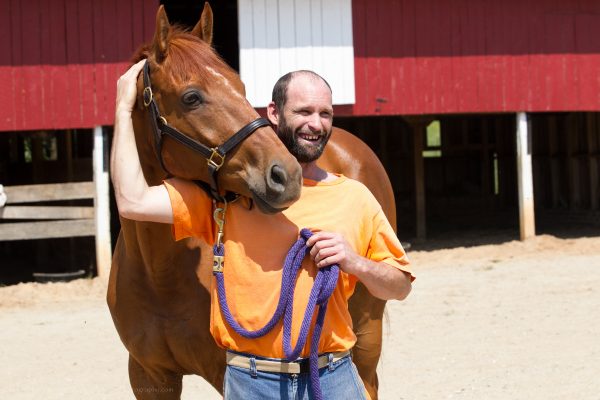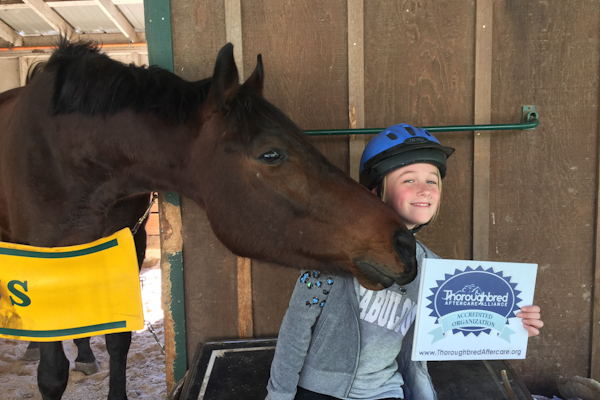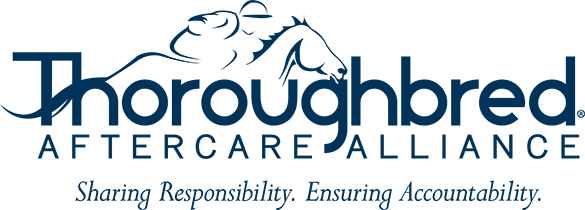By: Melissa Bauer-Herzog
We’ve all heard the saying, attributed to different sources, “There is something about the outside of a horse that is good for the inside of a man.” But it’s ringing true more than ever in Thoroughbred aftercare.
While many off-track Thoroughbreds (OTTBs) find second careers in the show arena or as a trail riding companion, in recent years many have made their way into therapy programs to help humans heal from a variety of traumas. Not surprisingly with the reach of the Thoroughbred Aftercare Alliance some of its accredited organizations take part in helping everyone from those who have physical limitations to veterans trying to adapt to life after being in a war zone.
TAA-accredited organization Out Side In didn’t originally plan to use OTTBs, but its first horse off the track showed how the lives of retired racehorses can run parallel to the humans they help. After getting that first horse off Craigslist, the program continued to help transition Thoroughbreds to life off the track with the assistance of veterans. While the veterans were there to help the horses, the horses also helped them. The same was seen in Out Side In’s other therapy programs as well.
“The impact that our horses have on the people we serve is immeasurable,” said Jennifer McVoy, Out Side In’s executive director. “The amazing thing is that every person is impacted by the horses in different ways. From a woman who has been sexually abused being able to gain confidence by knowing she can control a 1,200-pound animal to a child who, for once, feels he can have a relationship where he will not be judged, to a veteran who finally feels understood and needed, horses have helped our clients in so many ways.”
Working wonders
Sarah Stein the barn manager at the Thoroughbred Retirement Foundation’s Second Chances in Sykesville, Md., sees the same thing with the inmates brought in from Central Maryland Correctional Facility to work with the OTTBs in her care. Whether they’re there for a day or six months, she often sees their attitudes change when the horses reflect the inmates behavior back to them.
“It’s about relationships, starting with how that person has a relationship with themselves because the relationship that someone has with themselves is directly felt by the horse,” Stein said. “If a person is living with rage or self-loathing or a lack of self-worth, the horse responds to that person [differently] than the person who has confidence, calmness, and kindness inside of them. I can see the change of how people know they have to shift their energy and their self-awareness. For a lot of people, it’s always looking at, ‘What are other people doing?’ and being successful with horses really requires you to look at yourself.
“They’ll look at what’s inside and what energy are you giving off. They pick up on such subtle vibes. What we present and how we see ourselves—and therefore how we present ourselves to the horses—the horses can inform us of that. That’s a much easier way to get people to look at how they are presenting themselves and what they might be feeling inside.”

An inmate in TRF’s Second Chances Program. Credit: Debby Thomas
But it isn’t just those in the program that benefit from the OTTBs. For Square Peg Foundation‘s founder Joell Dunlap, seeing the impact horses have on disabled children has made a major impact on her. One such story that sticks in her head is that of a child who had a breakthrough moment while riding.
“I was riding with a young boy in my lap and I was singing a game to him where I would sing, ‘How many canter steps do we do?’ to the tune of ‘The Wheels on the Bus’ song, and I’d say a number and then we would canter that number of steps,” Dunlap said. “After about five minutes of this—this child that everyone thought didn’t have much in the way of receptive language skills—I sang ‘How many canter steps do we take?’ and this little boy whispers ‘Eleven.’ I’m glad he was in my lap so that he didn’t see me crying while we cantered our 11 steps. We now regularly get three-to five-word sentences from him when we ride.”
Building bridges
Using Thoroughbreds and building bridges into the Thoroughbred world are important for Out Side In. For the organization, having the support of the TAA goes much further than just the funds the TAA provides.
“Not only has the funding been an incredible help, but the rigorous accreditation process helps give our organization credibility,” McVoy said. “Thoroughbred owners can feel confident when looking for a place to retire their horse that they will be provided with the best care and donors can be sure that the organization is operating at the highest standards and their money is being used appropriately.
“In addition, TAA helps give a platform for promoting Thoroughbreds as therapy horses, which we believe will help reduce the stigmas of racehorses and increase demand for them after their racing career is over.”
While Second Chances isn’t a typical therapy program, Stein sees how simply working with the horses helps the inmates change. From building their confidence to teaching life skills and inspiring goals for life after prison, being with the Thoroughbreds plays a big part in the lives of everyone who enters the program.
“Even if I only have them for a week or two weeks or three weeks or a month, I try very hard to make sure each day they get something different than they would anywhere else in their life,” Stein said. “There is one graduate who has gone on to work at the racetrack and he’s been doing that now for a year and he’s been pretty successful. He wants to continue to work his way up the ladder of employment in the horse industry and that success story is very rewarding.
“The fact that I can be a part of a program that provides the opportunity for someone to do that with their life as well as providing an opportunity to potentially just have someone here for a day that they are worthy.”
There may be disagreements over who said how good horses are for humans, but the people behind these organizations agree on the need for more hippotherapy programs of all kinds to improve the lives of both humans and the OTTBs who can serve in them.
“Our goal has been to develop a finely tuned program that can be easily replicated with the proper training and qualified professionals,” McVoy said. “Our hope is that we can help other aftercare organizations incorporate veterans into their rehabilitation/retraining process. In addition, other qualified therapy centers may consider incorporating the use of OTTBs into their programs. By providing education and an easily replicated program, we can increase life-changing opportunities across the country for both veterans and OTTBs.”
While therapies show the outside of a horse may be good for the inside of a man, the inside of a man may also prove to be the best thing that happens to horses coming off the track into TAA-accredited programs in years to come.
The article was originally printed in the 2019 TAA Magazine produced by the Daily Racing Form. Click here to view the magazine.














